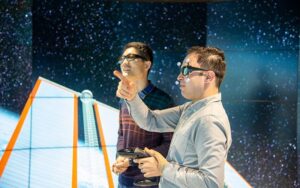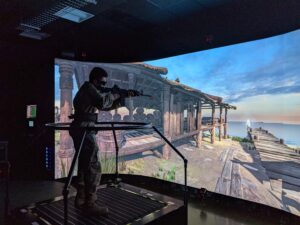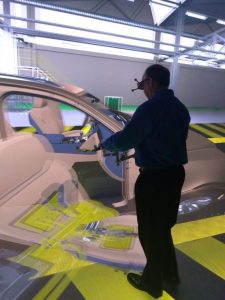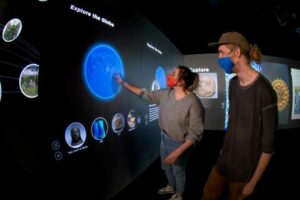While media outlets tout that virtual reality (VR) technology is new and leading edge, VR isn’t the future. It’s now. VR has already permeated most major corporations and educational institutions. At Mechdyne, we’ve been helping clients use VR and visualization systems to enable discovery for the past 25 years.
Most of the press is also focused on head mounted displays (HMDs). These have evolved tremendously over decades but they are not the only way to experience immersive VR. For many use cases, they are the ideal tool. In other cases, there are better tools to achieve your goals. It’s easy to get swept away with the glamour and “coolness” of high end technology, but technology is a catalyst for greater things. Remember: don’t fall in love with the technology, fall in love with your goals. If the technology is appealing but can’t do what you need it to, it’s worthless.
The Solution is Key
 We don’t ask our clients what technology they want. We ask what problem they’re trying to solve and recommend a solution (usually including technology) that will perform the best for their specific use case.
We don’t ask our clients what technology they want. We ask what problem they’re trying to solve and recommend a solution (usually including technology) that will perform the best for their specific use case.
Because of their increasing visibility in the consumer realm, HMDs are what most people think of when they hear “virtual reality.” However, various organizations that use VR as a business tool tend to opt for larger immersive systems, such as a CAVE™ or a Powerwall™. There are benefits and disadvantages to both options. HMDs take up less space at a much lower cost, but aren’t as collaborative and users may experience issues with peripheral vision. Large systems may offer a more immersive experience and can accommodate larger groups of people, but they take up more space and require a larger upfront investment.
As technology advances, the desire for high resolutions increases. New 8K projectors offer detail far beyond what HMDs can display. However, 8K resolution might not be required by all use cases. And, 8K technology will add to the cost of a large-scale system. Budget and space restrictions should be considered when evaluating the solution and expected ROI.
VR to Support Training
 These larger systems aren’t in the public eye nearly as often because businesses, not consumers, are buying and utilizing them. VR has broad appeal as a training tool for dangerous, expensive, or similarly problematic jobs or situations. In fact, we have designed VR systems that are used for military exercises, safety training, and medical simulations. Still, training is only one of the countless ways VR can be beneficial in the real world. As VR becomes more advanced, businesses and organizations are finding it essential in architecture and construction design, manufacturing, research and education, and entertainment.
These larger systems aren’t in the public eye nearly as often because businesses, not consumers, are buying and utilizing them. VR has broad appeal as a training tool for dangerous, expensive, or similarly problematic jobs or situations. In fact, we have designed VR systems that are used for military exercises, safety training, and medical simulations. Still, training is only one of the countless ways VR can be beneficial in the real world. As VR becomes more advanced, businesses and organizations are finding it essential in architecture and construction design, manufacturing, research and education, and entertainment.
VR to Support Prototyping and Manufacturing
 Top vehicle manufacturers have minimized the use of physical vehicle prototypes – today they build virtual prototypes, saving substantial design time and investment costs. Virtual prototypes allow designers to see their vehicle from every angle. They can move to the side to see something better, crouch down, or walk around the model while tracking technology reacts to their movements. This allows them to identify design issues, and then quickly and easily make changes to the prototype at no extra cost. Design evaluations which used to take days or even weeks can now be done in hours, with no physical production whatsoever.
Top vehicle manufacturers have minimized the use of physical vehicle prototypes – today they build virtual prototypes, saving substantial design time and investment costs. Virtual prototypes allow designers to see their vehicle from every angle. They can move to the side to see something better, crouch down, or walk around the model while tracking technology reacts to their movements. This allows them to identify design issues, and then quickly and easily make changes to the prototype at no extra cost. Design evaluations which used to take days or even weeks can now be done in hours, with no physical production whatsoever.
VR to Support Education and Research

Educational institutions tend to have the most diverse portfolio of VR applications. It seems professors, students, and researchers from any discipline can find a way to augment their work using virtual reality. Scientists explore atoms, travel through the solar system, and are able to review research results which used to take two weeks in just two hours. With VR displays, aspiring art historians examine classic pieces in detail while the originals sit thousands of miles away. Later that day, a team of geologists uses the same system to look inside the layers of the earth in search of oil deposits. Commercial partners use the University of Arkansas at Little Rock’s VR system to review and optimize building designs. This provides a 5-10 percent building cost saving due to minimized errors that used to be identified during the actual construction of the building.
Looking to the Future
No matter the purpose, VR users experience countless benefits. In most cases, the cost savings and project time reduction alone are more than enough to deem the system a success. Of course, there are also other unmeasurable advantages to implementing VR, like the ability to see and scale minuscule or enormous objects, viewing the inside of something that wouldn’t be possible physically, and virtually traveling to faraway cities, ecosystems, and even planets.

